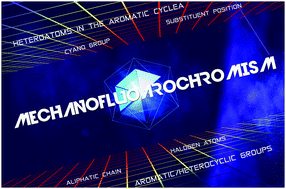Effective structural modification of traditional fluorophores to obtain organic mechanofluorochromic molecules
Abstract
Mechanofluorochromic (MFC) materials are a class of materials for which distinct changes in the solid-state emission colors can be achieved by applying an external force. The MFC properties of most of these materials originate from a change in their molecular packing mode upon exposure to mechanical stimuli. The molecular packing modes are closely related to the molecular conformations and the intermolecular interactions, which makes it possible to alter the packing modes through appropriate structural modifications of specific fluorophores. A relatively clear relationship between the structure and the MFC properties is crucial to optimize the use of conventional organic fluorescent molecular skeletons in constructing effective MFC compounds. This review focuses on the effect of several important factors affecting the generation of new and/or high-contrast MFC-active organic compounds via the structural modification of conventional fluorophores, including the introduction of aliphatic chains, appropriate aromatic/heterocyclic groups, cyano groups, halogen atoms, and heteroatoms to the aromatic ring or modification of the substituent position.

- This article is part of the themed collection: Recent Review Articles


 Please wait while we load your content...
Please wait while we load your content...